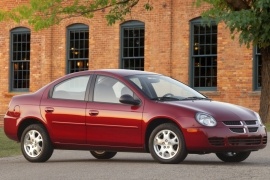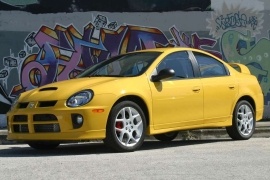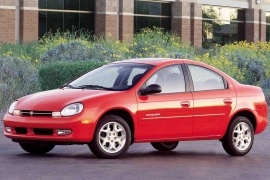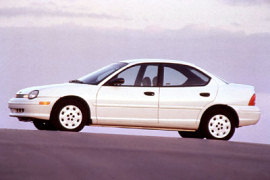DODGE Neon Models/Series Timeline, Specifications & Photos
First production year: 1994
Engines: Gasoline
The Neon was introduced in 1995 to fight against the massive import market in the compact sedan segment. Still, its poor sales made Chrysler ax it from the assembly line in 2005.
After five years into production, the sales for the Dodge/Chrysler/Plymouth Neon didn't go well. Even if it was offered with sporty packages, the vehicle's sales were low. In 2000, Dodge claimed that it changed more than 1000 parts of the car and advertised it as a new generation. Just three years later, in 2003, it was the final refresh of the car.
From the outside, the biggest change was for the front fascia. A new, cross-hair grille design was adopted. The bumper was changed as well, but the headlights remained the same. For specific markets, such as Canada, Dodge ditched the Neon name and sold it as 2.0 SXT only. It featured aluminum wheels, a deck-spoiler, and a sunroof as the only options available for the exterior look.
Inside, the Dodge wish to offer the car at the lowest possible price was obvious. The cheap materials could have been seen all over the place. But Dodge did that to offer a sports compact car under USD 20.000, which was way cheaper than most of its competitors. The air-conditioning was offered as an option.
Under the hood, Dodge installed a 2.0-liter naturally aspirated engine. It was paired to a 5-speed manual as standard, but a 4-speed automatic transmission was on the options list.
The sport-compact car in the U.S. was mainly dominated by the import cars from Japan and Germany. But Dodge gave them a proper answer with the Neon SRT4.
In the years 2000, there was a trend for fast and cheap vehicles. The mph/dollar factor was important and the Dodge Neon SRT4 was a good answer. They were cheap to buy and easy to modify.
The three-box sedan shape of the car could have been mistaken with a family sedan. While the normal Neon was exactly that kind of car, the SRT4 was different. Its front fascia told that. A big bumper with a Dodge Viper-like four slots and two round fog-lights were different than the rest of its siblings. An air-intake on the hood also warned the bystanders that that was not the ordinary grocery-car. A big, oversized wing on the trunk had only a styling factor and it was among the first to be replaced by the owners.
Inside, the Dodge wish to offer the car at the lowest possible price was obvious. The cheap materials could have been seen all over the place. There was even a factory-installed boost gauge that looked like it was stuck after the car left the factory. But Dodge did that to offer a sports compact car at under USD 20.000, which was way cheaper and less powerful than the Subaru Impreza WRX or the Mitsubishi Lancer Evo. The car featured only front power windows.
Under the hood, the Dodge Neon SRT4 featured a 2.4-liter turbocharged engine mated to a standard 5-speed transmission. In the first production year, it was offered with a 215 hp and an open differential. Starting with 2004, the engine was pumped-up to 230 hp and the transmission received a limited-slip differential.
After a slow start on the market, Chrysler launched a second generation of the Neon in 1999 as a 2000 model year, after just four years since the first Neon rolled out the assembly line.
The idea of an economical, sporty, youthful sedan offered by Chrysler on the American market was not bad, but the result was far under the company's expectations. Honda Civic, Toyota Corolla, Volkswagen Jetta, and the recently upgraded Nissan Sentra were on top of the sales while the Dodge/Plymouth Neon struggled to survive on the market.
The exterior was enhanced with the introduction of a new pair of bigger headlights with a narrow grille under the bonnet crossed by a slim horizontal chromed line that connected the inside-mounted turn-signals. On the lower part of the bumper, a wide grille that resembled a smiling face was added. Unfortunately, it was more of a grim than a smile. One of the features that made the car look good on the first generation was the frameless windows. Starting with the 2000 model-year, the Neon featured framed ones.
Inside, Chrysler installed a decent looking dashboard, with an instrument cluster that started above the center stack and was extended to the door panel. Regardless of the trim levels, there were no standard power-windows for the rear, but they were on the options list. Another issue with the Neon was the material's quality. The dash, door panels, center stack, and all of the other surfaces were made out of hard plastic.
Under the hood, Chrysler offered a 1.6-liter engine (the same as the one found in the first generation of the Mini) and two versions of a 2.0-liter unit. The power went to the front wheel via a 5-speed manual or a 4-speed automatic.
Chrysler proved that it could build good econobox cars when it introduced the Neon in 1994, which surprised the market with its low entry-level price and powerful engine.
Usually, when a carmaker built a low-budget car, its base engine was powerful enough to move the vehicle from A to B and nothing more. But when Chrysler did it with the Neon, it did more than that and was able to hit the 60 mph (97 kph) mark in less than eight seconds. That was already hot-hatch territory, and the Neon was just a low-budget car.
The base trim level showed white paint and gray bumpers. Its door handles were black, and so were the mirrors, while the 13" steel-wheels featured dog-dish hubcaps. The styling was rounded in the early '90s trends with some of the weirdest-looking rounded headlights on the market. Its unusual high greenhouse made the car stood apart from its competition.
Inside, the base version offered dual airbags, and that was it. The power steering and the tachometer were on the base versions' options list but standard on the upper trim levels. There were no pockets in the doors, but it provided two cup-holders in the center console.
But the big surprise was under the hood, where Chrysler installed a 2.0-liter, fuel-injected engine. The base version provided 136 hp, while the 16-valve version pumped out 150 horses. Dodge paired them to a five-speed manual as standard, with an option for a three-speed automatic.



